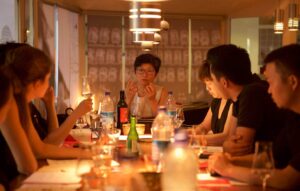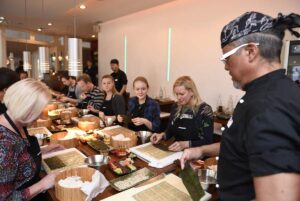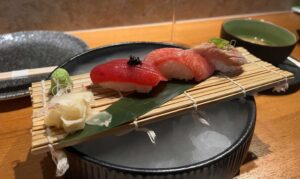It is often said that Japanese cuisine also means eating with your eyes. We have also mentioned this several times in our articles.
Preparing and serving food is always a quest for enjoyment - most cuisines around the world certainly agree on this.
Characteristic of the fine japanese cuisine are the subtle, often contrasting yet harmonizing flavours, a special feel for the seasons and the art of making the best possible use of these seasonal ingredients.
And of course, the matching Japanese tableware ((和食器, Wa-shokki) intensifies the enjoyment experience even more.
For fine Japanese cuisine, various types of tableware made of different materials such as ceramic and porcelain plates and lacquered bowls are used at the same time. Japanese cuisine is probably the only cuisine in the world that uses such a variety of tableware in just one meal, such as bowls and soup bowls in different colors, designs and sizes, small plates and serving platters, small bowls and deep bowls, and so on.
The deep devotion to the Thoughts of hospitality (Omotenashi/おもてなし) ultimately leads to the fact that in Japanese cuisine, great care is taken not only with the dishes, but also with the selection of the appropriate tableware to delight the guest in a variety of ways and to give him a special pleasure, a "meal with the palate and with the eyes".
Tableware in Kaiseki
You may already know that Japanese cuisine is generally based on "one soup and three dishes" (Ichi-jyū San-sai, 一汁三菜).
For example, the Japanese usually eat rice served in porcelain bowls, soup served in lacquered bowls and meat or fish served on porcelain plates. Side dishes of vegetables, mushrooms and seaweed are served on smaller porcelain plates.
Just as the ingredients change depending on the season and occasion, it is also traditional for the dishes to change accordingly. The basic idea The main reason for this is the great care taken to select tableware that suits the season and to present the dishes beautifully. The result is a total work of art that frames the chef's efforts and presents them to the guest in the best possible way.
Kaiseki Ryōri is a typical example of this type of cuisine, which pays great attention to both food and tableware. The chef selects seasonal ingredients and arranges them on porcelain or lacquerware plates that could be considered works of art in their own right. The chef invests all his skill and passion in entertaining the guests by creating a "seasonal landscape" of his own creation.
In Japan, the taste of the food and at the same time the choice of serving utensils is an important factor in whether a meal is perceived as good or bad. A special way to enjoy a kaiseki ryōri is to imagine which The chef's thoughts when he chose these dishes and the accompanying ingredients.
As the shape and size of Japanese tableware varies depending on the food to be served, there is a natural difference between tableware used for formal dishes such as kaiseki and the tableware for everyday use at home.
At this point, it is fitting to introduce the variety of tableware that is mainly used for Kaiseki Ryōri.
Popular tableware types in Japan
The most important materials for tableware in Japan are ceramics and porcelain.
It is said that there are more than 60 production sites and more than 4,000 kilns in Japan. Of the 60 production sites, 32 are recognized as traditional Japanese handicrafts by the Ministry of Economy, Trade and Industry.
The history of pottery in Japan is long and begins with the pottery of the Jomon period (縄文). In the Kofun period (古墳), the technique of forming pottery on a potter's wheel and firing it in a kiln at high temperature was introduced from Korea, and in the Nara period, the technique of using colored glazes was introduced from China.
From the Muromachi period (室町) to the Azuchi-Momoyama period (安土桃山), the popularity of chanoyu (茶の湯), or the tea ceremony, gave ceramics a uniquely Japanese character and strongly influenced the culture of the whole country. Porcelain also appeared in the Edo period (江戸). The painted colored porcelain was exported abroad and charmed European royals and aristocrats. In addition, Japanese ceramics were exhibited at the World Expo in the Meiji period, triggering a Japanism boom. In this way, Japanese Ceramics through the adoption of various techniques and the deep connection with the culture of their own country has developed over the course of history.
Special forms of ceramics and porcelain in the Kaisekt kitchen
Ceramics and porcelain are used for many dishes at Kaiseki Ryōri.
Nimono-wan (煮物椀): As the name suggests, this is a deep vessel for serving stewed dishes (nimono) that has a lid to keep the food warm until it is served to the customer.
Mushi-wan (蒸し椀): Can be used for steamed dishes such as steamed chawan-mushi. These also have a lid.
As both are vessels with lids, they are also collectively referred to as Futa-mono (蓋物) labeled.
Meshi-wan (飯碗): A container for rice (meshi).
Hachi (鉢): A medium-deep bowl that is not as deep as a wan, but not so shallow that it cannot hold soup. A bowl has a wide opening and can be used for several purposes.
Sara (皿): A completely flat plate without any depth, with a diameter of around 18 to 24 cm. In general, this is the best known type of tableware and is used to serve a variety of dishes. It is mainly used for appetizers, grilled dishes, tempura, hassun, etc.
Mukōzuke (向付): Mukōzuke is a general term for deep plates with a diameter of about 15 cm, which are used to serve seasonal dishes with dressing or sashimi. In the "one soup, three dishes" place setting, there is a rice bowl on the left and a soup bowl in the foreground on the right. The name "Mukōzuke" comes from the dish that is placed beyond (Mukō) the rice bowls. Mukōzuke is also used as a name for a special form of kaiseki menu.
Choku: This is a general term for small plates and bowls. Depending on the shape, choku can be used instead of mukōzuke. There are deep small bowls (kobachi, 小鉢), shallow small plates (kozara, 小皿) and dipping bowls (tsuyu-iri, つゆ入り) for tempura and soba.
Ceramics and porcelain are also used for sake cups to Sake served with the dishes and for the cups in which tea is served at the end of a meal.
Pictorial tableware design in the Japanese kitchen
The designs for each vessel are varied and are chosen to match the idea and season of the kaiseki.
For example, there is a pattern that is essentially called Kisshō-monyō (吉祥文様). Kisshō means a good omen. Typical Kisshō-monyō designs include the following symbols:
The three plants "Pine", "Bamboo" and "Plum" are symbols of good luck because they grow well even in the cold winter months. This pattern is used to express congratulations and is also used on festive occasions such as wedding receptions and New Year.
Shō-Chiku-Bai (松竹梅, pine, bamboo and plum)
The three plants "Pine", "Bamboo" and "Plum" are symbols of good luck because they grow well even in the cold winter months. These patterns are used to express good luck and are also popular for festive occasions such as wedding receptions and New Year.
Tsuru-kame (鶴亀, crane and turtle)
Both are used for festive occasions, as they are seen as symbols of longevity.
Oshidori (鴛鴦, mandarin duck)
Mandarin ducks are a species of bird that lives near water. The pairs are always close together, hence the traditional Japanese term "Oshidori-fūfu" for a married couple who are closely connected. The sight of the mandarin duck is considered a good omen, which is why this motif is often used at weddings and other occasions.
Koi (鯉, carp)
Ever since the Chinese legend that carp could swim up a raging river and become dragons, carp have been popular as lucky charms and symbolize the Desire for success in life. Carp also have a very long lifespan and are considered an auspicious symbol of longevity and immortality.
Hōō (鳳凰, phoenix)
The phoenix is a legendary bird that only appears in times of peace and prosperity and is believed to bring people peace, money and various other blessings. would bring. Since ancient times, it has been depicted as a motif on many paintings and dishes because of its promise of happiness and beauty.
Asa-no-ha (麻の葉, hemp leaves)
Hemp leaves grow up to 4 meters tall in 4 months, straight and strong, so the hemp leaf pattern is associated with a child's desire for healthy growth. The pattern is also said to ward off evil, and has often been used for baby clothes since ancient times.
Shippō (七宝, Cloisonné)
Cloisonné refers to the seven treasures mentioned in Buddhist scriptures: Gold, silver, ruri (blue gemstones), hari/玻璃 (crystal), shakogai/しゃこ貝 (giant clam), coral and menō/瑪瑙 (striped minerals). This pattern is a good omen for the eternal chain of circles and is associated with wishes for happiness, harmony and karma. This pattern also symbolizes that human relationships and connections are as valuable as the seven treasures (cloisonné).
Flora, fauna and natural landscape
Designs with seasonal flowers, insects and animals reinforce the sense of the seasons. Cherry blossoms, plum blossoms, grapes, the moon, silver grass, snow bamboo, bell beetles, dragonflies and many other patterns are also available and delight the heart of the Japanese, for whom the thought of nature is often an inner vanishing point.
Various vessels alongside ceramics and porcelain
In addition to pottery and porcelain, the following types of vessels are used:
Shikki (漆器, lacquerware):
Lacquerware is a beautiful craft made by coating a wood or paper base with a natural resin coating obtained from the sap of the lacquer tree, which is native to Japan and other East Asian countries. The traditional base material is wood, but in recent years plastic (synthetic resin) has also been used as a base material. Lacquerware is heat-resistant and does not get warm in the hand, even when food is served hot. It is also resistant to acids and alkalis, which makes it an excellent choice for tableware. This property is very practical for soups and stew bowls.
Gyaman (ぎやまん, glassware):
Glassware that shines like crystal is called "Gyaman=Guillaman" in Japanese cuisine. The name "guillaman" comes from the Dutch word for "diamond" and was first used in Nagasaki (長崎) during the Edo period. Unlike the "glass and beadro (ビードロ)" that existed in Japan until then, diamond-cut glass deeply impressed people at the time. Since then, hand-cut faceted glassware has spread and developed into Edo Kiriko glassware and Satsuma Kiriko glassware. Gyaman is used in summer to create a cool atmosphere.
Wooden tableware:
Bamboo baskets, strainers and other bamboo products as well as curved wooden containers made from cedar, cypress and other materials. Uncoated wooden tableware, which has the fragrant texture of natural wood, is found as a craft in many regions. The scent of cedar and cypress, the natural beauty of the wood grain and the freshness of green bamboo are
Japanese feel the season through the dishes
Japanese tableware uses a variety of materials and shapes to enhance the beauty of a meal. Each material such as lacquerware, ceramic, porcelain and glassware has different functions such as keeping warmth or coolness. They have a different appearance and therefore a different effect. This creates a special harmony in combination with the meal.
Japanese tableware really comes into its own when you are enjoying a seasonal meal. In Japan, you can intensely feel the four seasons: Spring, summer, fall and winter. The changes in the course of the year, in the plants, flowers and creatures in each of these seasons have a great influence on the Japanese sense of beauty.
For example, glass tableware is often used during the hot summer months to create a cool impression. Green bamboo baskets and colanders are also popular. Porcelain plates give a clean impression and are considered suitable for summer. Celadon vessels are particularly suitable for the beginning of summer.
In contrast, warm, rustic and warm ceramic pots are used in winter. Alternatively, lacquerware is also a good choice as it retains heat. Lacquerware is luxurious and is used for festive occasions, so lacquer plates are used for New Year's meals, which the Japanese consider to be the most important.
If you have the opportunity to enjoy a kaiseki (such as our occasional one in Munich Kaiseki Events), please pay attention not only to the dishes, but also to the tableware on which they are served. And think about the thought and care the chef has put into the dishes and their presentation.






